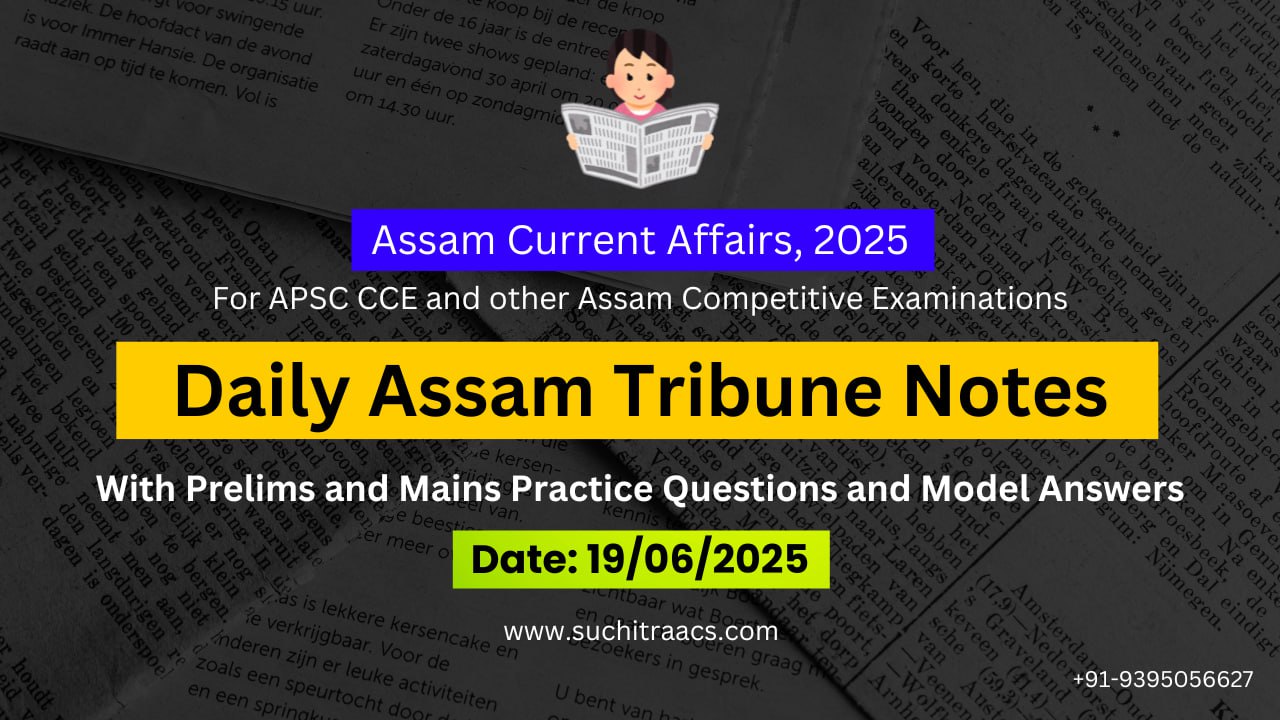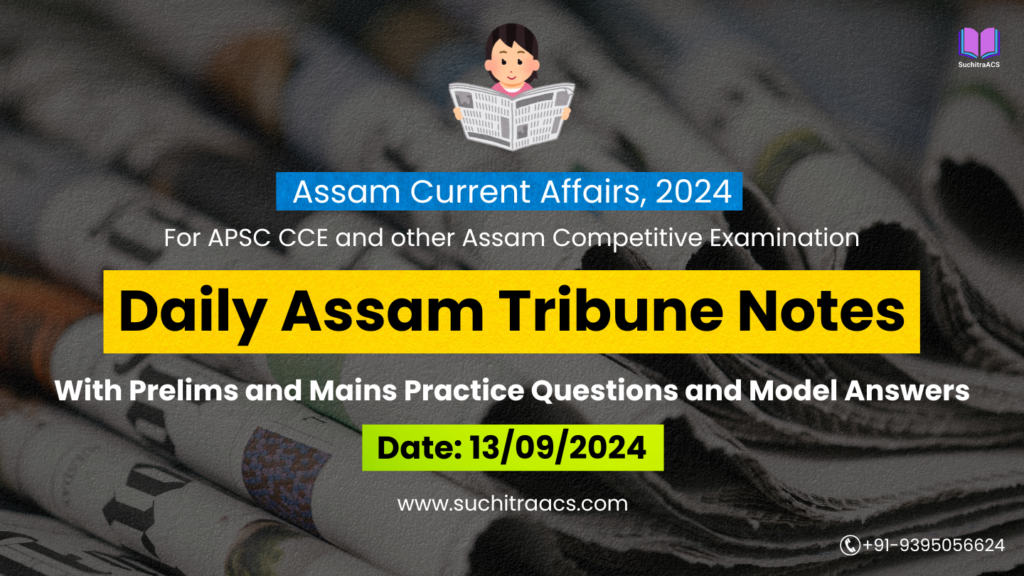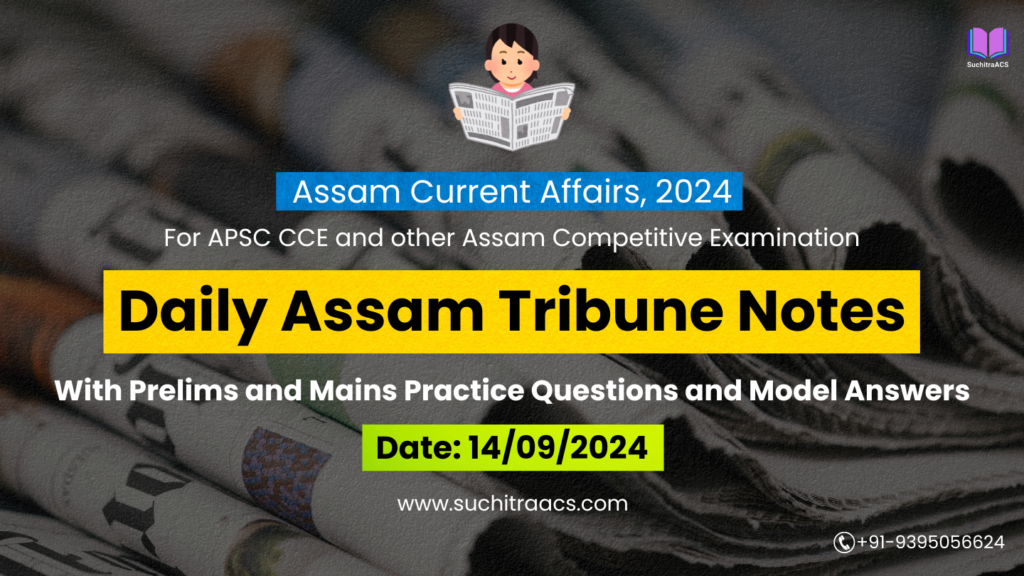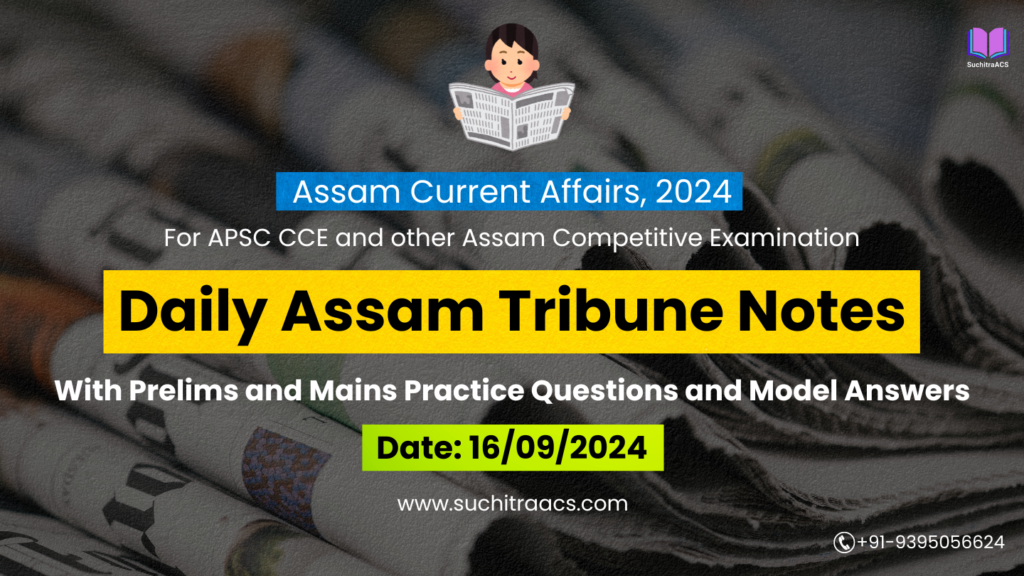APSC Current Affairs: Assam Tribune Notes with MCQs and Answer Writing (19/06/2025)
For APSC CCE and other Assam Competitive examinations aspirants, staying updated with current affairs is vital. This blog covers most important topics from the Assam Tribune today (19-06-2025). These issues are key for both APSC Prelims and Mains preparation, offering insights into the APSC CCE Syllabus.
✨ APSC CCE Online Coaching, 2026
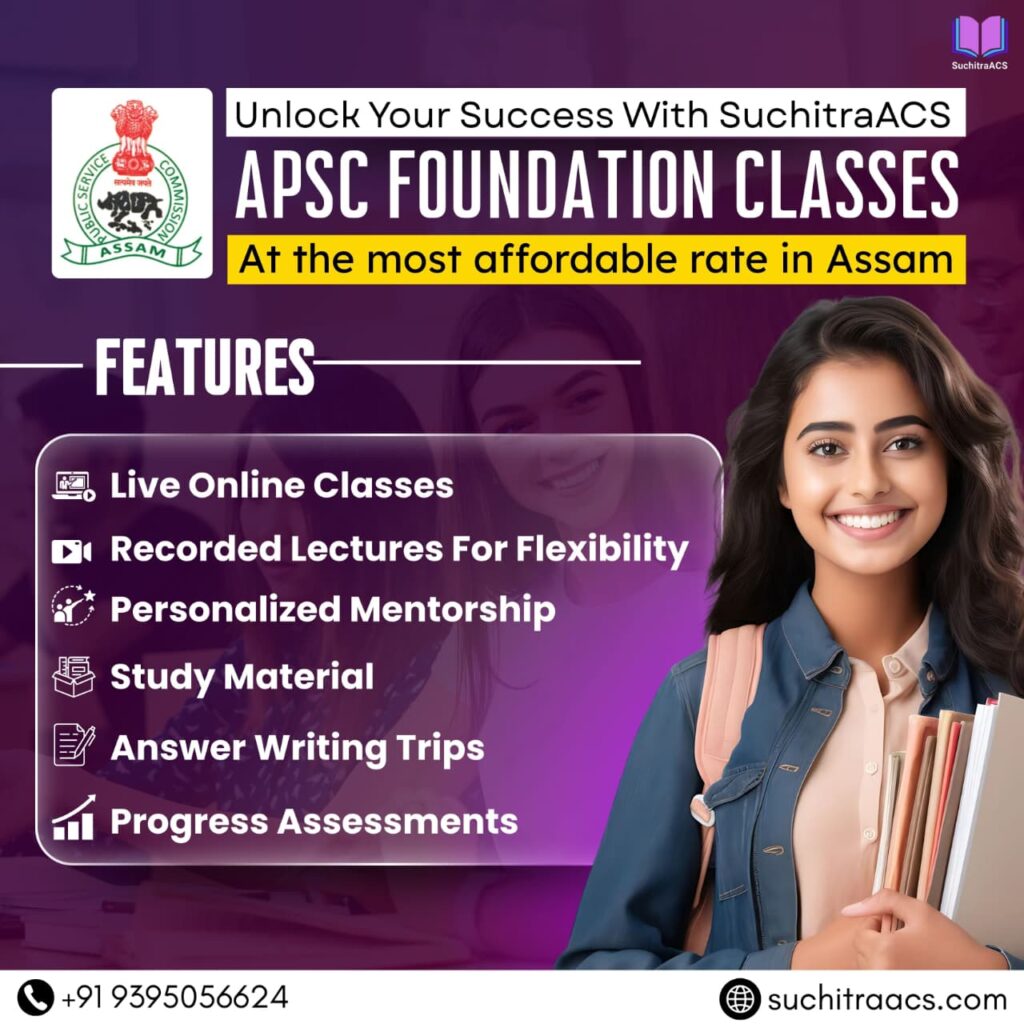
🧾 Implementation of Clause 6 of Assam Accord: Report Finalisation by August 2025
📘 GS Paper 2 (Polity & Governance): Federalism | Constitutional Provisions | Government Policies
📘 GS Paper 5 (APSC Specific): Assam Accord | Identity & Autonomy | Ethnic Issues
🔹 Introduction
Clause 6 of the Assam Accord (1985) is central to preserving the cultural, linguistic, and social identity of the Assamese people. The Government of Assam, through its Implementation Department, held the 6th sub-committee meeting and confirmed that the final report will be submitted to the Chief Minister before August 8, 2025. This marks a major step toward realising a long-pending constitutional safeguard.
🔑 Key Points
| Element | Details |
| Assam Accord Year | 1985 |
| Clause 6 Objective | Constitutional, legislative & administrative safeguards for Assamese |
| Recent Meeting Chaired By | Atul Bora (Minister) |
| Participants | AASU, Implementation Dept., senior officials |
| Recommendations Under Focus | 39 proposals by Justice Biplab Kumar Sarma Committee |
| Submission Deadline for Final Report | Before August 8, 2025 |
| Other Proposal | Formation of a sub-panel on Clause 7 (economic development) |
| Demand from AASU | Govt. affidavit in SC for re-examination of NRC |
🧠 Prelims Pointers
Assam Accord (1985): Signed between GoI, AASU, and AAGSP to end anti-foreigner agitation
Clause 6: Protects Assamese identity; calls for constitutional safeguards
Clause 7: Economic development of Assam
Justice Biplab Sarma Committee (2020): Submitted 190-page report on Clause 6
AASU: All Assam Students’ Union – signatory and key pressure group
NRC 2019: Final list excluded 19 lakh people; controversy over genuine inclusion
📝 Mains Pointers
A. Importance of Clause 6 Implementation
Preserves indigenous culture, identity, and language
Symbolic of the Centre’s commitment to regional concerns
Politically significant for maintaining social harmony
Needed to balance post-NRC anxieties and ethnic fears
B. Challenges in Implementation
| Issue | Explanation |
| Lack of Legal Clarity | Who qualifies as “Assamese” is still debated |
| Delayed Decision-Making | Years have passed since the Justice Sarma Report was submitted |
| Political Resistance | Competing demands from tribal and migrant groups |
| NRC Overlap | Any decision affects the demography post-NRC implementation |
| Coordination Hurdles | Between Central and State governments |
C. Government Initiatives
Justice Biplab Kumar Sarma Committee setup (2019)
Creation of Implementation Department for Assam Accord
Engagement with stakeholders like AASU, civil society
Assurance of legislative protections for Assamese people
D. Way Forward
| Solution | Details |
| Define “Assamese” Clearly | Inclusive yet culturally rooted definition through consensus |
| Legislative Action | Introduce bills for constitutional safeguards in Parliament |
| Multi-Stakeholder Dialogue | Involve tribal councils, AASU, linguistic groups |
| Fast-Track NRC Appeals | Coordinate NRC review with Clause 6 implementation |
| Cultural Funding | Support for Assamese literature, language, media under Clause 6 |
📑 Relevant Constitutional Provisions
Article 29 & 30: Rights to conserve distinct language, script, and culture
Article 371B: Special provision for tribal autonomous councils in Assam
Sixth Schedule: Protection of tribal areas (may influence Clause 6 policies)
🧩 Conclusion
Clause 6 of the Assam Accord represents a constitutional promise to the Assamese people. Timely and effective implementation will not only safeguard cultural identity but also restore faith in democratic federalism. The coming months are critical to bridging the gap between intent and execution.
🛫 New Direct Flight Between Guwahati and Bangkok Announced by Air India
📘 GS Paper 2: India and Its Neighbours | Government Policies
📘 GS Paper 3: Infrastructure – Transport | Tourism
📘 GS Paper 5 (APSC): Assam – Connectivity | Act East Policy | Regional Development
🔹 Introduction
Air India has announced a direct international flight between Guwahati and Bangkok, which is set to boost cross-border tourism, trade, and cultural exchange between Northeast India and Southeast Asia. The announcement aligns with India’s broader Act East Policy, aiming to enhance the strategic and economic integration of the Northeast with ASEAN nations.
🔑 Key Details
| Feature | Description |
| ✈ Airline | Air India (under Tata Group) |
| 🌍 International Route | Guwahati (LGBI Airport) – Bangkok (Suvarnabhumi) |
| 📅 Frequency | 3 times a week (as per initial plan) |
| 🌐 Strategic Relevance | Strengthens Act East connectivity and ASEAN outreach |
| 💼 Economic Impact | Boost for tourism, hospitality, and trade sectors |
| 🚧 Infrastructure Support | LGBI airport recently upgraded for international handling |
🧠 Prelims Pointers
LGBI Airport (Guwahati): Lokpriya Gopinath Bordoloi International Airport
Act East Policy: India’s foreign policy strategy to deepen ties with ASEAN and East Asia
Thailand–India Connectivity: Part of the India–Myanmar–Thailand Trilateral Highway
UDAN International: Scheme to promote regional air connectivity to nearby countries
ASEAN: Association of Southeast Asian Nations – 10 member states including Thailand, Myanmar, etc.
📝 Mains Pointers
A. Strategic Significance of Guwahati–Bangkok Connectivity
Positions Guwahati as the gateway to Southeast Asia
Reduces dependency on Kolkata/Delhi for NE outbound traffic
Boosts tourism circuits like Kaziranga–Chiang Mai–Luang Prabang
Facilitates student and medical travel from NE to ASEAN countries
Symbolic of India’s commitment to Neighbourhood First + Act East
B. Economic & Regional Benefits
| Sector | Benefit |
| Tourism | Influx of Thai tourists to Assam and vice versa |
| Trade | Potential cargo tie-up for goods like tea, handicrafts, organic produce |
| Employment | Jobs in airport services, travel agencies, and local markets |
| Cultural Exchange | Buddhist circuit tourism linking Sarnath–Tawang–Bangkok |
| Education & Healthcare | Easier student exchange, medical travel from Assam to Thai hospitals |
C. Challenges
| Challenge | Explanation |
| Visa Policy & Costs | E-visa limits or delays may impact uptake |
| Sustainability of Route | Flight needs consistent footfall to avoid suspension |
| Security & Surveillance | Need for upgraded customs, immigration, anti-trafficking vigilance |
| Limited Awareness | NE residents may lack knowledge of cross-border travel benefits |
📑 Relevant Schemes & Policies
UDAN (Ude Desh ka Aam Nagrik) International
Act East Policy (2014 onwards)
ASEAN–India Connectivity Plan
Guwahati Smart City Infrastructure Plan
India–Thailand Air Services Agreement
🧭 Way Forward
| Recommendation | Strategy |
| Integrated Tourism Marketing | Promote NE–ASEAN tour packages via DoNER and Tourism Ministry |
| Cargo Linkages | Set up Guwahati–Bangkok cargo services for tea, handicrafts |
| Cross-Border Education Ties | Academic MoUs between Guwahati universities and Thai institutions |
| Airport as Regional Hub | Position Guwahati as transit for Bhutan, Meghalaya, Nagaland |
| Sustainability Monitoring | Periodic viability analysis and feedback from flyers |
🧩 Conclusion
The Guwahati–Bangkok air route is more than just a flight—it’s a strategic step toward placing Assam on the global connectivity map. By synergising transport, tourism, and diplomacy, this initiative can make Northeast India a true fulcrum of India’s Act East aspirations.
🛣️ NHIDCL’s Warning on Slow Road Projects in Assam and Northeast
📘 GS Paper 3: Infrastructure | Governance | Investment Models
📘 GS Paper 2: Centre-State Relations | Federal Coordination
📘 GS Paper 5 (APSC): Assam – Connectivity | Border Infrastructure | NE Development
🔹 Introduction
The National Highways and Infrastructure Development Corporation Ltd. (NHIDCL) has flagged serious concerns over the slow pace of national highway projects in Assam and the Northeast. In a progress review meeting chaired by Union Minister Nitin Gadkari, the agency warned of the risk of de-scoping or cancellation of contracts where construction firms have failed to show progress despite repeated extensions.
🔑 Key Highlights
| Element | Description |
| 🚧 Key Projects Under Review | Sivasagar–Sonari–Namrup Road, Haflong Bypass, Aizawl–Tuipang, Tura–Dalu |
| 🏢 Agency Involved | NHIDCL – PSU under Ministry of Road Transport and Highways (MoRTH) |
| ⚠️ Main Concerns | Delay in land acquisition, poor contractor capacity, inadequate coordination |
| 🛑 Possible Action | Contracts may be terminated or de-scoped for repeated non-compliance |
| 🏛️ State Coordination Lacking | Assam and Arunachal officials reportedly delayed clearances |
| 💡 Centre’s Push | Projects are critical under Act East Policy, Border Area Development, and Bharatmala |
🧠 Prelims Pointers
NHIDCL: 100% GoI-owned company to execute road projects in challenging terrains, especially Northeast
Bharatmala Pariyojana: National highway development initiative with focus on economic corridors and border areas
De-scoping: Removal of unachieved project components from contract scope
Hybrid Annuity Model (HAM): Public-private partnership model combining EPC + annuity
Act East Highway Corridors: Link Northeast to Myanmar, Bangladesh, and Southeast Asia
📝 Mains Pointers
A. Strategic Importance of Highway Projects in Assam & NE
Ensures regional connectivity to border towns, reducing isolation
Facilitates logistics for defence, disaster response, and trade
Boosts local employment and market access in remote districts
Enhances India’s connectivity with ASEAN under the Act East vision
Reduces travel time and logistics cost for central and state schemes
B. Challenges Identified by NHIDCL
| Challenge | Explanation |
| Land Acquisition Delays | States slow in compensating or resolving land disputes |
| Low Contractor Capacity | Smaller firms unable to mobilise resources in hilly terrain |
| Weather Constraints | Monsoon and landslide-prone zones slow work seasonally |
| Inadequate Monitoring | Lack of digitised dashboards or third-party audits |
| State-Centre Disconnect | Poor follow-up by PWD/Revenue departments in land handover |
C. Centre’s Recommendations
State governments to enforce performance guarantees strictly
Use of pre-fabricated bridges and tunnels to speed up hilly section work
Establish single-window land acquisition portals
Greater use of drones and geo-tagged reporting
Enforce penalty clauses for defaulting contractors
📑 Relevant Policies & Reports
Bharatmala Pariyojana – Flagship highway expansion scheme
PM Gati Shakti Yojana – Multimodal infrastructure master plan
NEC Road Development Programme – Roads to strategic border zones
India–Myanmar–Thailand Trilateral Highway – Cross-border connectivity
15th Finance Commission – Border infrastructure recommendations
🧭 Way Forward
| Recommendation | Strategy |
| Contractor Vetting | Prioritize firms with terrain experience in bid evaluation |
| Decentralised Execution | Empower local NHIDCL project offices for faster decisions |
| Community Engagement | Use village councils and VDCs to resolve land disputes |
| Green Infra Approach | Ensure ecological safeguards in wildlife corridors |
| Digital Monitoring | Project dashboards with live progress maps and drone footage |
🧩 Conclusion
NHIDCL’s concerns reflect a deeper issue in infrastructure governance in the Northeast — the gap between policy ambition and field execution. For Assam to truly benefit from national programs like Bharatmala and Act East, there must be tight Centre-State coordination, robust contractor accountability, and citizen-sensitive land policies.
APSC Prelims Practice Questions
✅ Topic 1: Clause 6 of the Assam Accord
1. Clause 6 of the Assam Accord primarily deals with:
A. Economic development of Assam
B. Border fencing between Assam and Bangladesh
C. Constitutional and legal safeguards for Assamese people ✅
D. Implementation of NRC process
🧠 Explanation:
Clause 6 of the Assam Accord (1985) provides for constitutional, legislative, and administrative safeguards to protect the cultural and linguistic identity of Assamese people.
2. Which committee was constituted to recommend the implementation mechanism for Clause 6?
A. Bezbaruah Committee
B. Biplab Kumar Sarma Committee ✅
C. Rajiv Gandhi Committee
D. Nagaon Peace Committee
🧠 Explanation:
The Justice Biplab Kumar Sarma Committee was formed in 2019 and submitted its report in 2020 suggesting 39 key recommendations.
✅ Topic 2: Guwahati–Bangkok Direct Flight Announcement
3. The Guwahati–Bangkok air route directly supports which Indian policy initiative?
A. Neighbourhood First Policy
B. Digital India Mission
C. Make in India
D. Act East Policy ✅
🧠 Explanation:
The direct flight strengthens India’s Act East Policy by improving physical connectivity between Northeast India and Southeast Asia.
4. Which of the following cities are part of the India–Myanmar–Thailand Trilateral Highway?
- Moreh
- Mandalay
- Bangkok
- Guwahati
Select the correct answer:
A. 1, 2, and 3 only ✅
B. 1 and 2 only
C. 2, 3, and 4 only
D. All of the above
🧠 Explanation:
- Moreh (Manipur), Mandalay (Myanmar), and Bangkok (Thailand) are key nodes.
- Guwahati is not directly on this highway but acts as a regional hub.
✅ Topic 3: NHIDCL & Delays in Road Projects
5. NHIDCL is primarily responsible for:
A. Border fencing in the Northeast
B. Inland water transport projects
C. National highway construction in hilly and border areas ✅
D. Electricity distribution in tribal regions
🧠 Explanation:
National Highways and Infrastructure Development Corporation Ltd. (NHIDCL) is a GoI PSU under the Ministry of Road Transport and Highways created to execute road projects in tough terrains like the Northeast, Jammu & Kashmir, and Uttarakhand.
6. “De-scoping” in infrastructure contracts refers to:
A. Escalating the cost of project phases
B. Removing underperforming contractors
C. Eliminating parts of the project scope due to persistent non-completion ✅
D. Assigning project sections to foreign firms
🧠 Explanation:
De-scoping means withdrawing specific components of a project contract that cannot be delivered within the timeframe or quality requirements.
✅ Topic 4: Ethical Governance and Clause 6 Implementation
7. Which Article of the Indian Constitution guarantees the right of any section of citizens to conserve their distinct language, script, or culture?
A. Article 14
B. Article 19(1)(a)
C. Article 29 ✅
D. Article 30
🧠 Explanation:
Article 29 provides that any section of the citizens residing in the territory of India having a distinct language, script, or culture of its own shall have the right to conserve the same.
APSC Mains Practice Question
📝 Mains Question:
Q. Discuss the constitutional, political, and administrative challenges in the implementation of Clause 6 of the Assam Accord. Suggest a balanced roadmap to address concerns of identity, inclusivity, and federal cooperation.
📘 Model Answer
Introduction
The Assam Accord, signed in 1985 between the Government of India, AASU, and AAGSP, sought to resolve the long-standing agitation against illegal immigration. Clause 6 of the Accord promises constitutional, legislative, and administrative safeguards to protect the cultural, linguistic, and social identity of Assamese people. Despite decades passing, its implementation remains incomplete, largely due to definitional ambiguities and political sensitivities.
Constitutional Significance of Clause 6
- Article 29 & 30: Protects minority cultural and linguistic identities
- Sixth Schedule & 371B: Offers a template for regional autonomy
- Clause 6 is expected to enhance cultural federalism, not just administrative protection
Challenges in Implementation
| Category | Challenges |
| Legal/Definitional | Lack of consensus on who qualifies as “Assamese” – pre-1951 settlers? Post-1971? |
| Political Sensitivity | Balancing rights of ethnic Assamese with those of tribal communities and post-1971 migrants |
| Administrative Coordination | Disagreement between Centre and State on report timelines and implementation modalities |
| Overlapping Processes | Tension between NRC outcomes and Clause 6 implementation |
| Trust Deficit | Delays in adopting Biplab Sarma Committee’s 39 recommendations have reduced public faith |
Justice Biplab Sarma Committee (2020) – Key Recommendations
- Reservation for Assamese people in Assembly seats and government jobs
- Regulation of land rights, trade licenses, and cultural institutions
- Constitutional amendment to define “Assamese people”
- Strengthening of indigenous language and cultural promotion bodies
Balancing Identity with Inclusivity
| Stakeholder | Concern |
| Indigenous Assamese | Fear of cultural extinction due to demographic changes |
| Tribal Communities | Want parallel safeguards without being subsumed |
| Bengali-origin Citizens | Risk exclusion from identity-based benefits |
| Civil Society & Students | Demand transparent and timely implementation |
Way Forward: A Balanced Roadmap
| Strategic Pillar | Actionable Suggestions |
| Legal Clarity | Define “Assamese people” through public consultation and SC vetting |
| Stakeholder Dialogue | Form multi-ethnic consultation group including AASU, tribal councils |
| Legislative Action | Enact a new State Act with constitutional backing for protections |
| NRC Review Linkage | Synchronise Clause 6 implementation with NRC appeal framework |
| Cultural Investment | Fund Assamese-medium schools, literature, and institutions under cultural rights |
Conclusion
Clause 6 is more than a policy—it is a promise of cultural justice. Its implementation must not exclude or alienate communities but rather foster a federal and inclusive Assamese identity. With political will, transparent processes, and community consensus, Assam can honour its past while securing a united future.
✨ APSC CCE Courses, 2025-26 offered by SuchitraACS
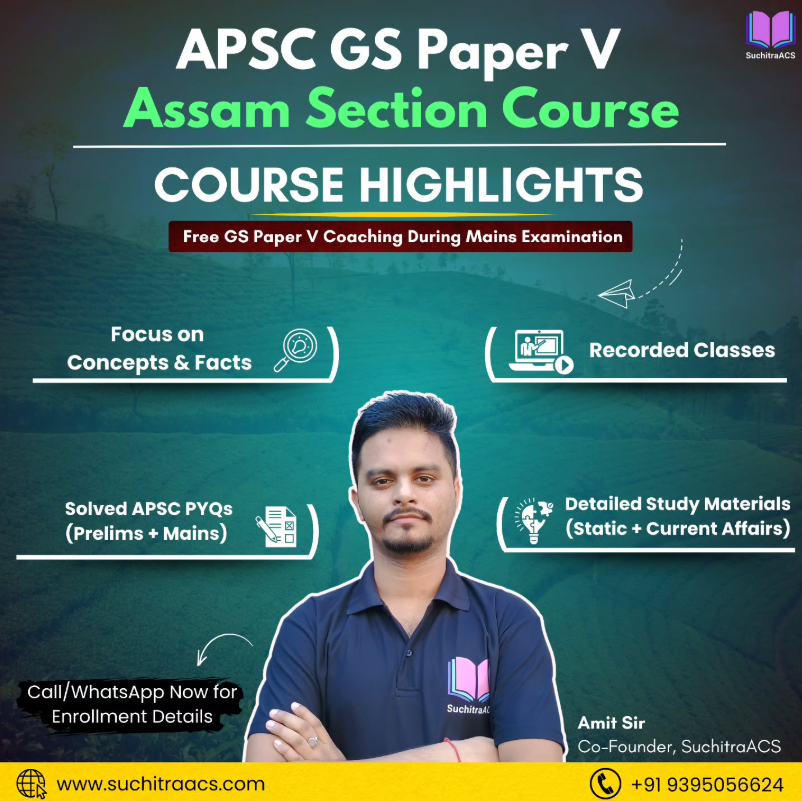

🔔 Join Our WhatsApp Study Group!
For exclusive access to premium quality content, including study materials, current affairs, MCQs, and model answers for APSC CCE and other Assam competitive exams.
Click here to join: SuchitraACS Study WhatsApp Group
📚 Want to know more about SuchitraACS’s most affordable courses?
Click here to know more: SuchitraACS Courses for APSC CCE and Assam Competitive Examinations

